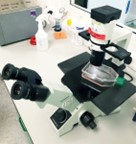Guest blog by Grace Gregory, Student, University of Manchester
 I'm Grace and I am one of two students at the University of Manchester funded by NF2 BioSolutions UK. People with Neurofibromatosis Type 2 (NF2) often have many tumours that develop in the central nervous system along the spine and brain requiring risky surgeries over a lifetime with few alternatives.
I'm Grace and I am one of two students at the University of Manchester funded by NF2 BioSolutions UK. People with Neurofibromatosis Type 2 (NF2) often have many tumours that develop in the central nervous system along the spine and brain requiring risky surgeries over a lifetime with few alternatives.The aim of my PhD is to investigate potential therapeutic avenues to reduce the number of surgeries needed and provide more treatment options to those with NF2.
I am currently looking at immune cells such as T cells and macrophages that can infiltrate into NF2 brain tumours correlating with a higher tumour growth rate. By understanding the immune cell interactions and niches within the tumours, this could lead to the development of drugs targeted against specific immune cells to treat those with NF2. But what goes on in my research day to day?

At the moment, I spend about 70% of my time in the lab and 30% at my desk planning and analysing my data. When I get to the office, I usually hang out my dripping raincoat (Manchester can be a bit soggy!), I grab a cup of tea and plan my day.

Then, I check on my cells in the tissue culture lab. Currently, I am using an immortalised human THP-1 monocyte cell line, as well as human peripheral blood mononuclear cells (hPBMCs) that are separated out of donor blood for use in our research. Today they are growing happily and healthily!
If, like today, my cells seem healthy then I can run an experiment. I add pro-inflammatory or anti-inflammatory stimulants to the culture media with the aim of characterising their effects on the immune cells. I am looking to replicate the microenvironment found within the NF2 brain tumours that the immune cells might encounter so I can replicate it in vitro.


To determine the effect of the stimulants I lyse the cells, extract the RNA and convert it to cDNA ready for quantitative reverse transcription PCR (RT-qPCR). This way I can see which genes are up or downregulated in the immune cells in response to a pro- or anti-inflammatory environment.
I run my samples in a 384 well plate, looking for 18 different genes of interest. I always cross my fingers when I set the qPCR machine running!
By understanding gene expression in these cells we can more accurately replicate the immune microenvironment of the NF2 brain tumours with the hope that we can use these immune cells in vitro to test new potential therapeutics. This will allow us to investigate off target effects, toxicity and specificity of candidate drugs within a controlled environment during preclinical testing. The aim is that we can translate these findings into viable, life changing drugs for people with NF2.
If you have any questions about my research or anything at all, I warmly welcome emails to grace@nf2biosolutions.org or you can reach out on twitter here: @GraceGregory_
A One Nucleus Guest blog by Grace Gregory, Student, University of Manchester. Please email natalie@onenucleus.com for more information on guest blogging'